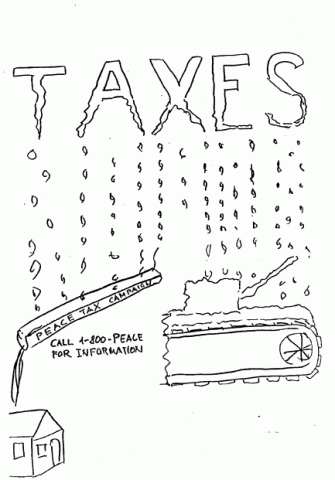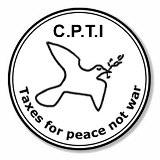Personal Experiences, Seizures, Ideas and Strategies
Workshop 5
Facilitator: Klaus Hecker Resource Person: Lynne Weiss
After brief introductions we watched a video about War Tax Resistance in the United States. This featured people who were trying to resist war taxes in various ways and their reasons for doing so. It included people who refused to file tax returns, others who kept their income down to avoid paying tax, and people involved with Alternative Tax Funds.
In the discussion Lynne explained that in New England they run workshops for potential war tax resisters. They also have a project where veterans visit schools and talk about the army and about not signing up for it. Apparently they had to challenge the law to be allowed to promote peace in schools. In the United Kingdom it is hard to get into schools unless a teacher invites one - their local school asked Arthur and Ursula Windsor to talk to students doing a project on people whose religion had changed their lives. The video also raised the issue of using images of war and violence which can be painful. Perhaps this may be necessary to have an impact.
Other points were that war tax resistance in the United States has been going since 1948 or before and the Peace Taxpayers as an organisation is well established. It would seem that in the States the system is less predictable than in the United Kingdom with the response of the Inland Revenue Service varying from district to district. It was stressed that one should not volunteer information to the tax collectors - if they want to know anything they will contact you.
Lynne then talked about the case of Randy Kehler and Betsy Corner whose house in Colrain, Massachusetts was seized because they had refused their taxes. In this long-running campaign the house, or land around it, was occupied continuously by many small affinity groups to try to stop it being sold. There was a firm commitment to non-violence, it involved many people, and it has raised the issue and stimulated more grassroots activity. The house itself was eventually sold but war tax resisters are still present.
In the United Kingdom the emphasis is more or lobbying for legislative changes rather than direct war tax resistance. The tax system means that most people have their tax deducted from their salary which makes tax resistance harder, although a small number of people do withhold their taxes or try to redirect them to non-military purposes. The taxmen always seem to get their money; some resisters have had their goods taken arid auctioned by bailiffs, a few have gone to prison.
In Germany the current focus is on the Supreme Court action and work on legislation which is being considered at present.
The Dutch have, like the United States, developed an alternative tax form. They did this to mark their 10th anniversary and to make people aware of how much money is paid to the military. The form enables people to estimate how much of their income tax, VAT, or car tax goes to the military and to choose how they would like it redirected. Klaus mentioned that in Germany they had tried to devise a slide rule to calculate how much tax went to military purposes but they ran into problems of how to produce it cheaply and the difficulty of updating it every year ... perhaps a computer programme could be written...
The workshop then split into three groups to discuss different ideas.
One group discussed using posters and billboards/advertising hoardings. Points to consider include the size of posters, the cost of printing, the use of colour, how posters should be distributed. A large billboard poster may only be up for a few weeks, while smaller posters could be used for longer. Libraries and community centres could be asked to display posters. In the United States one billboard company donated space for a war tax resistance poster. Spain and Germany have both produced coin stickers.
Graphic ideas and images to use we considered. We were not sure whether we should avoid military symbols (tanks, guns, etc.) It was suggested we should consult advertising/public relations experts for their advice on how people reacted to military images. One idea was to show visually that taxes turn into tanks (or guns) (unless we act to stop this). Perhaps this could be shown with a picture of a tank made of coins, or banknotes. Another idea was the word ‘taxes’ melting and dripping into a tank or a. peace tax campaign (see drawing). Another suggestion was for the poster to invite comments What do you think about paying taxes for war or peace?
and to provide pens for people to write their comments onto the poster.
Another group discussed alternative tax forms. It was felt that this was a good idea and that it should become an international campaign. Trix van Vugt from BWD (Netherlands) reports:
As a result of this workshop we would like to make a proposal for an international campaign. We all have to deal with the problem of how to get people interested in and aware of WTR. We from the Dutch BWD developed a form similar to the Alternative Revenue Form of the American WRL. It is an alternative tax form on which you can estimate your personal contribution to the military and redirect that amount to causes worthy of our money. We developed this form as a way to make people aware of how much they contribute to the military personally and to make them think about alternative purposes. We also ask them if they would appeal to a CO law if there is one.
Awareness is our first goal, the second one is to hold a sort of pool, to get figures on how much people want to redirect their money and to what alternatives. We want to use these figures for publicity. We spread this form among peace groups this year, (we sent it with their magazines); we intend to spread it among other groups, e.g. environmental, next year.
We propose that each country develops a similar farm specific to your own tax system, and that we start this campaign internationally. We could keep each other informed during the coming two years and compare the outcomes at the next conference in 1994.
The third group discussed finding allies and came up with a list of individuals and organisations which could be approached and won over. These include leading personalities. MPs, editors and journalists. Groups include pop groups, groups concerned with ecology, Third and Fourth World issues, churches, labour unions, women's organisations, alternative and co-operative movements, local communities, anti-nuclear, youth groups, CO movements, those concerns with human rights and civil liberties, veterans. It was recognised that there is a split between those with strong religious beliefs and those who recognise the issue of conscientious objections.
It was recognised that we need to challenge OUR assumption that other groups will not help us. We have to ask, it might take only one letter or phone call, or it might take a long time, but we will not know unless we ask. The possibility of receiving anonymous donations was mentioned.
In the discussion at the end Svend proposed that we need a permanent peace tax symbol to be used on everything. This would help to make links and to ensure continuity. But it was recognised that while the international work was important we need to continue to build our local, national campaigns.
The evaluation at the end of the workshop revealed that Klaus was happy, that everyone felt it had been useful and had been very participatory.
Report written by Monica Frisch (Peace Tax Campaign, United Kingdom)

